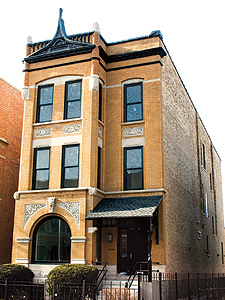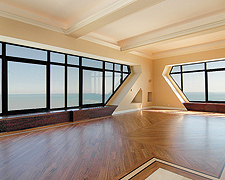Send tips about high-end home sales to dennis@rodkin.com.
Thy Neighbor’s House
Rather than endure another misplaced McMansion, a local developer buys a 19th-century building and transforms it into a stylish 21st-century home
Photograph: Chris Guillen |
| West Lincoln Park List price: $3.495 million Sale price: $3.070 million |
When Marvin Ullman learned in 2004 that this building-then a six-flat-was for sale, he believed he could foresee its future: “It would be torn down for one of those Georgian McMansions that have nothing to do with the history and character of Chicago,” he recalls today.
Embellished with intricate limestone detailing on the façade and a painted metal “witch’s cap” on the roof’s parapet, the building dates to the 1880s. To save it, Ullman, an architect, preservationist, and developer who has been rehabbing buildings in the neighborhood for more than 30 years, bought it himself, paying $1.45 million.
Over the next two years, he completely rebuilt the interior and put an addition on the back. He ended up with an 8,000-square-foot house with four levels; there are six bedrooms, two new custom-designed staircases, and a master suite that fills the second floor.
“These older houses go on the market and people have the mentality that a new house will be better,” Ullman says. “[But] the old house has the bones. If it’s rehabbed properly, it will outlast the new house.” On top of that, Ullman says, today’s setback rules and other building requirements would have kept a new house from having as much space as this one.
Ullman sold the house in December 2006; at press time, the name of the buyer had not yet appeared in public records.
A Tall Order
At the Hancock Center, a grocer combines two lofty condos for one big-ticket sale
 |
| Streeterville List price: $2.495 million Sale price: $1.850 million |
In July 2005, Adi Mor bought two neighboring units-a studio and a two-bedroom condo-on the 91st floor of the John Hancock Center, the building’s second-highest residential level. Both units desperately needed updating; what’s more, the floors had been raised and the ceilings lowered, which gave the space a cramped feeling. “They were horrible to look at,” says Wes Janisz, Mor’s sales agent at Koenig & Strey GMAC.
Mor, who owns the five Garden Fresh supermarkets, had bought the two units as an investment, paying (according to Janisz) $1.5 million for the pair. He combined them into one 2,600-square-foot condominium, with three bedrooms and three bathrooms. There are views of the lake to the north and northeast, and the talk-show host Jerry Springer lives next door. Janisz says the condo is now the largest home in the building.
When Mor sold the renovated unit this past November, its $1.85-million price tag was the highest on record for the Hancock, according to the Multiple Listing Service of Northern Illinois. The name of the buyer could not be identified from public records. Janisz says that a smaller unit on the 92nd floor had earlier sold for $50,000 more in a private deal, which does not appear in MLSNI records.
Condo Shift
Locally, downtown Chicago may be the condominium capital, but in 2006, the suburbs pulled ahead in one segment of that market. This past year, some 4,000 suburban apartments were converted to condos, compared with only about 300 downtown, says Gail Lissner of Appraisal Research Counselors, which tracks the metro real-estate market. In 2005, downtown Chicago-which for Lissner includes the Loop and the Near North, Near South, and Near West sides-had about 4,000 conversions and the suburbs about 3,800. Most of those conversions occurred in DuPage and northwestern Cook counties, says Lissner, who cites two factors at play: There is a steady stream of suburban buyers looking for entry-level homes, and, she adds, “for the owners of these class B and class C apartments built in the late 1970s, the conversion to condo is a great exit strategy.”


